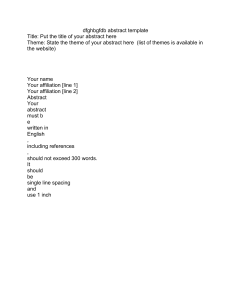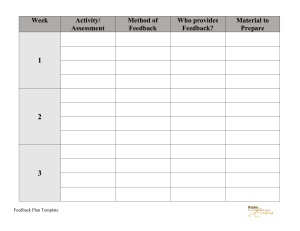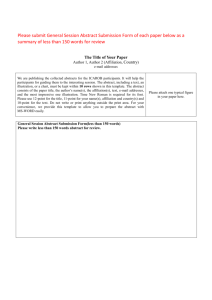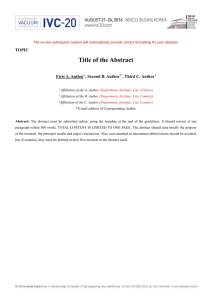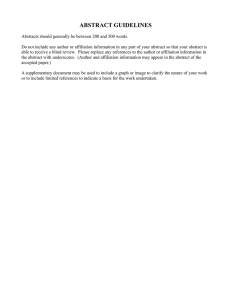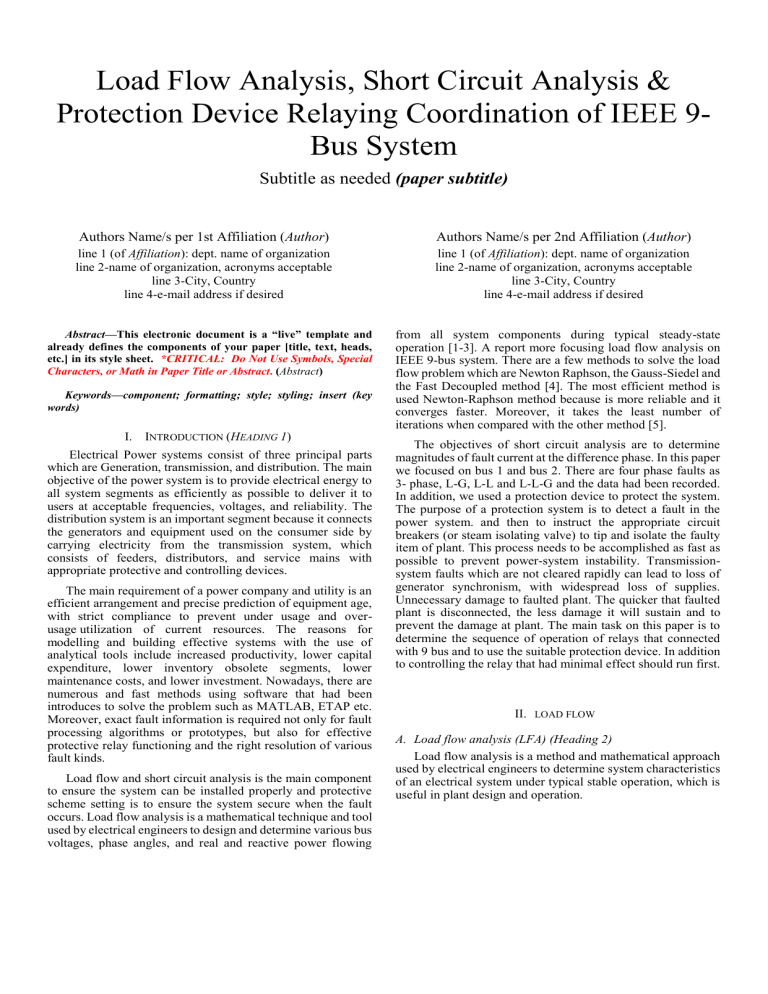
Load Flow Analysis, Short Circuit Analysis & Protection Device Relaying Coordination of IEEE 9Bus System Subtitle as needed (paper subtitle) Authors Name/s per 1st Affiliation (Author) Authors Name/s per 2nd Affiliation (Author) line 1 (of Affiliation): dept. name of organization line 2-name of organization, acronyms acceptable line 3-City, Country line 4-e-mail address if desired line 1 (of Affiliation): dept. name of organization line 2-name of organization, acronyms acceptable line 3-City, Country line 4-e-mail address if desired Abstract—This electronic document is a “live” template and already defines the components of your paper [title, text, heads, etc.] in its style sheet. *CRITICAL: Do Not Use Symbols, Special Characters, or Math in Paper Title or Abstract. (Abstract) Keywords—component; formatting; style; styling; insert (key words) I. INTRODUCTION (HEADING 1) Electrical Power systems consist of three principal parts which are Generation, transmission, and distribution. The main objective of the power system is to provide electrical energy to all system segments as efficiently as possible to deliver it to users at acceptable frequencies, voltages, and reliability. The distribution system is an important segment because it connects the generators and equipment used on the consumer side by carrying electricity from the transmission system, which consists of feeders, distributors, and service mains with appropriate protective and controlling devices. The main requirement of a power company and utility is an efficient arrangement and precise prediction of equipment age, with strict compliance to prevent under usage and overusage utilization of current resources. The reasons for modelling and building effective systems with the use of analytical tools include increased productivity, lower capital expenditure, lower inventory obsolete segments, lower maintenance costs, and lower investment. Nowadays, there are numerous and fast methods using software that had been introduces to solve the problem such as MATLAB, ETAP etc. Moreover, exact fault information is required not only for fault processing algorithms or prototypes, but also for effective protective relay functioning and the right resolution of various fault kinds. Load flow and short circuit analysis is the main component to ensure the system can be installed properly and protective scheme setting is to ensure the system secure when the fault occurs. Load flow analysis is a mathematical technique and tool used by electrical engineers to design and determine various bus voltages, phase angles, and real and reactive power flowing from all system components during typical steady-state operation [1-3]. A report more focusing load flow analysis on IEEE 9-bus system. There are a few methods to solve the load flow problem which are Newton Raphson, the Gauss-Siedel and the Fast Decoupled method [4]. The most efficient method is used Newton-Raphson method because is more reliable and it converges faster. Moreover, it takes the least number of iterations when compared with the other method [5]. The objectives of short circuit analysis are to determine magnitudes of fault current at the difference phase. In this paper we focused on bus 1 and bus 2. There are four phase faults as 3- phase, L-G, L-L and L-L-G and the data had been recorded. In addition, we used a protection device to protect the system. The purpose of a protection system is to detect a fault in the power system. and then to instruct the appropriate circuit breakers (or steam isolating valve) to tip and isolate the faulty item of plant. This process needs to be accomplished as fast as possible to prevent power-system instability. Transmissionsystem faults which are not cleared rapidly can lead to loss of generator synchronism, with widespread loss of supplies. Unnecessary damage to faulted plant. The quicker that faulted plant is disconnected, the less damage it will sustain and to prevent the damage at plant. The main task on this paper is to determine the sequence of operation of relays that connected with 9 bus and to use the suitable protection device. In addition to controlling the relay that had minimal effect should run first. II. LOAD FLOW A. Load flow analysis (LFA) (Heading 2) Load flow analysis is a method and mathematical approach used by electrical engineers to determine system characteristics of an electrical system under typical stable operation, which is useful in plant design and operation. To do load flow analysis, we must first create the 𝑌𝑏𝑢𝑠 admittance matrix. The following is the nodal equation for a power system network utilizing 𝑌𝑏𝑢𝑠 . Where 𝐼, 𝑌𝑏𝑢𝑠 and 𝑉 are current. For example, the head margin in this template measures proportionately more than is customary. This measurement and others are deliberate, using specifications that anticipate your paper as one part of the entire proceedings, and not as an independent document. Please do not revise any of the current designations. Nodal equation can be generated for ‘n’ bus system is: III. PREPARE YOUR PAPER BEFORE STYLING Complex power can transmitted to bus 𝑖 is: Where 𝑄𝑖 is reactive and 𝑃𝑖 is real power for complex power 𝑏𝑢𝑠 𝑖 . Substituting 𝐼𝑖 in Before you begin to format your paper, first write and save the content as a separate text file. Keep your text and graphic files separate until after the text has been formatted and styled. Do not use hard tabs, and limit use of hard returns to only one return at the end of a paragraph. Do not add any kind of pagination anywhere in the paper. Do not number text heads-the template will do that for you. Finally, complete content and organizational editing before formatting. Please take note of the following items when proofreading spelling and grammar: A. Abbreviations and Acronyms Define abbreviations and acronyms the first time they are used in the text, even after they have been defined in the abstract. Abbreviations such as IEEE, SI, MKS, CGS, sc, dc, and rms do not have to be defined. Do not use abbreviations in the title or heads unless they are unavoidable. B. Units Use either SI (MKS) or CGS as primary units. (SI units are encouraged.) English units may be used as secondary units (in parentheses). An exception would be the use of English units as identifiers in trade, such as “3.5-inch disk drive.” Avoid combining SI and CGS units, such as current in amperes and magnetic field in oersteds. This often leads to confusion because equations do not balance dimensionally. If you must use mixed units, clearly state the units for each quantity that you use in an equation. Do not mix complete spellings and abbreviations of units: “Wb/m2” or “webers per square meter,” not “webers/m2.” Spell units when they appear in text: “...a few henries,” not “...a few H.” Use a zero before decimal points: “0.25,” not “.25.” Use “cm3,” not “cc.” (bullet list) B. Maintaining the Integrity of the Specifications The template is used to format your paper and style the text. All margins, column widths, line spaces, and text fonts are prescribed; please do not alter them. You may note peculiarities. Identify applicable sponsor/s here. If no sponsors, delete this text box (sponsors). C. Equations The equations are an exception to the prescribed specifications of this template. You will need to determine whether or not your equation should be typed using either the Times New Roman or the Symbol font (please no other font). To create multileveled equations, it may be necessary to treat the equation as a graphic and insert it into the text after your paper is styled. Number equations consecutively. Equation numbers, within parentheses, are to position flush right, as in (1), using a right tab stop. To make your equations more compact, you may use the solidus ( / ), the exp function, or appropriate exponents. Italicize Roman symbols for quantities and variables, but not Greek symbols. Use a long dash rather than a hyphen for a minus sign. Punctuate equations with commas or periods when they are part of a sentence, as in ab Note that the equation is centered using a center tab stop. Be sure that the symbols in your equation have been defined before or immediately following the equation. Use “(1),” not “Eq. (1)” or “equation (1),” except at the beginning of a sentence: “Equation (1) is ...” D. Some Common Mistakes The word “data” is plural, not singular. The subscript for the permeability of vacuum 0, and other common scientific constants, is zero with subscript formatting, not a lowercase letter “o.” In American English, commas, semi-/colons, periods, question and exclamation marks are located within quotation marks only when a complete thought or name is cited, such as a title or full quotation. When quotation marks are used, instead of a bold or italic typeface, to highlight a word or phrase, punctuation should appear outside of the quotation marks. A parenthetical phrase or statement at the end of a sentence is punctuated outside of the closing parenthesis (like this). (A parenthetical sentence is punctuated within the parentheses.) A graph within a graph is an “inset,” not an “insert.” The word alternatively is preferred to the word “alternately” (unless you really mean something that alternates). Do not use the word “essentially” “approximately” or “effectively.” to mean In your paper title, if the words “that uses” can accurately replace the word using, capitalize the “u”; if not, keep using lower-cased. Be aware of the different meanings of the homophones “affect” and “effect,” “complement” and “compliment,” “discreet” and “discrete,” “principal” and “principle.” Do not confuse “imply” and “infer.” The prefix “non” is not a word; it should be joined to the word it modifies, usually without a hyphen. There is no period after the “et” in the Latin abbreviation “et al.” The abbreviation “i.e.” means “that is,” and the abbreviation “e.g.” means “for example.” An excellent style manual for science writers is [7]. IV. USING THE TEMPLATE After the text edit has been completed, the paper is ready for the template. Duplicate the template file by using the Save As command, and use the naming convention prescribed by your conference for the name of your paper. In this newly created file, highlight all of the contents and import your prepared text file. You are now ready to style your paper; use the scroll down window on the left of the MS Word Formatting toolbar. A. Authors and Affiliations The template is designed so that author affiliations are not repeated each time for multiple authors of the same affiliation. Please keep your affiliations as succinct as possible (for example, do not differentiate among departments of the same organization). This template was designed for two affiliations. 1) For author/s of only one affiliation (Heading 3): To change the default, adjust the template as follows. a) Selection (Heading 4): Highlight all author and affiliation lines. b) Change number of columns: Select the Columns icon from the MS Word Standard toolbar and then select “1 Column” from the selection palette. c) Deletion: Delete the author and affiliation lines for the second affiliation. 2) For author/s of more than two affiliations: To change the default, adjust the template as follows. a) Selection: Highlight all author and affiliation lines. b) Change number of columns: Select the “Columns” icon from the MS Word Standard toolbar and then select “1 Column” from the selection palette. c) Highlight author and affiliation lines of affiliation 1 and copy this selection. d) Formatting: Insert one hard return immediately after the last character of the last affiliation line. Then paste down the copy of affiliation 1. Repeat as necessary for each additional affiliation. e) Reassign number of columns: Place your cursor to the right of the last character of the last affiliation line of an even numbered affiliation (e.g., if there are five affiliations, place your cursor at end of fourth affiliation). Drag the cursor up to highlight all of the above author and affiliation lines. Go to Column icon and select “2 Columns”. If you have an odd number of affiliations, the final affiliation will be centered on the page; all previous will be in two columns. B. Identify the Headings Headings, or heads, are organizational devices that guide the reader through your paper. There are two types: component heads and text heads. Component heads identify the different components of your paper and are not topically subordinate to each other. Examples include ACKNOWLEDGMENTS and REFERENCES, and for these, the correct style to use is “Heading 5.” Use “figure caption” for your Figure captions, and “table head” for your table title. Run-in heads, such as “Abstract,” will require you to apply a style (in this case, italic) in addition to the style provided by the drop down menu to differentiate the head from the text. Text heads organize the topics on a relational, hierarchical basis. For example, the paper title is the primary text head because all subsequent material relates and elaborates on this one topic. If there are two or more sub-topics, the next level head (uppercase Roman numerals) should be used and, conversely, if there are not at least two sub-topics, then no subheads should be introduced. Styles named “Heading 1,” “Heading 2,” “Heading 3,” and “Heading 4” are prescribed. C. Figures and Tables 1) Positioning Figures and Tables: Place figures and tables at the top and bottom of columns. Avoid placing them in the middle of columns. Large figures and tables may span across both columns. Figure captions should be below the figures; table heads should appear above the tables. Insert figures and tables after they are cited in the text. Use the abbreviation “Fig. 1,” even at the beginning of a sentence. TABLE I. Table Head copy TABLE STYLES Table Column Head Table column subhead Subhead Subhead a More table copy a. Sample of a Table footnote. (Table footnote) b. Fig. 1. Example of a figure caption. (figure caption) ACKNOWLEDGMENT (Heading 5) The preferred spelling of the word “acknowledgment” in America is without an “e” after the “g.” Avoid the stilted expression “one of us (R. B. G.) thanks ...”. Instead, try “R. B. G. thanks...”. Put sponsor acknowledgments in the unnumbered footnote on the first page. REFERENCES The template will number citations consecutively within brackets [1]. The sentence punctuation follows the bracket [2]. Refer simply to the reference number, as in [3]—do not use “Ref. [3]” or “reference [3]” except at the beginning of a sentence: “Reference [3] was the first ...” Number footnotes separately in superscripts. Place the actual footnote at the bottom of the column in which it was cited. Do not put footnotes in the reference list. Use letters for table footnotes. Unless there are six authors or more give all authors’ names; do not use “et al.”. Papers that have not been published, even if they have been submitted for publication, should be cited as “unpublished” [4]. Papers that have been accepted for publication should be cited as “in press” [5]. Capitalize only the first word in a paper title, except for proper nouns and element symbols. For papers published in translation journals, please give the English citation first, followed by the original foreign-language citation [6]. Figure Labels: Use 8 point Times New Roman for Figure labels. Use words rather than symbols or abbreviations when writing Figure axis labels to avoid confusing the reader. As an example, write the quantity “Magnetization,” or “Magnetization, M,” not just “M.” If including units in the label, present them within parentheses. Do not label axes only with [1] We suggest that you use a text box to insert a graphic (which is ideally a 300 dpi resolution TIFF or EPS file with all fonts embedded) because this method is somewhat more stable than directly inserting a picture. [4] [5] To have non-visible rules on your frame, use the MSWord “Format” pull-down menu, select Text Box > Colors and Lines to choose No Fill and No Line. units. In the example, write “Magnetization (A/m)” or “Magnetization (A ( m(1),” not just “A/m.” Do not label axes with a ratio of quantities and units. For example, write “Temperature (K),” not “Temperature/K.” [2] [3] [6] [7] G. Eason, B. Noble, and I.N. Sneddon, “On certain integrals of LipschitzHankel type involving products of Bessel functions,” Phil. Trans. Roy. Soc. London, vol. A247, pp. 529-551, April 1955. (references) J. Clerk Maxwell, A Treatise on Electricity and Magnetism, 3rd ed., vol. 2. Oxford: Clarendon, 1892, pp.68-73. I.S. Jacobs and C.P. Bean, “Fine particles, thin films and exchange anisotropy,” in Magnetism, vol. III, G.T. Rado and H. Suhl, Eds. New York: Academic, 1963, pp. 271-350. K. Elissa, “Title of paper if known,” unpublished. R. Nicole, “Title of paper with only first word capitalized,” J. Name Stand. Abbrev., in press. Y. Yorozu, M. Hirano, K. Oka, and Y. Tagawa, “Electron spectroscopy studies on magneto-optical media and plastic substrate interface,” IEEE Transl. J. Magn. Japan, vol. 2, pp. 740-741, August 1987 [Digests 9th Annual Conf. Magnetics Japan, p. 301, 1982]. M. Young, The Technical Writer’s Handbook. Mill Valley, CA: University Science, 1989.
